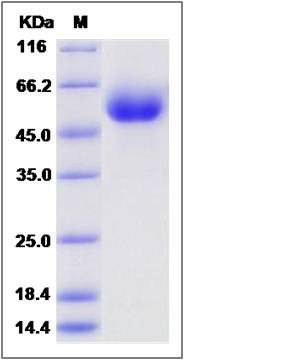Human SMPDL3A Protein (His Tag)
ASM3A,ASML3a,yR36GH4.1
- 100ug (NPP2507) Please inquiry
| Catalog Number | P13559-H08H |
|---|---|
| Organism Species | Human |
| Host | Human Cells |
| Synonyms | ASM3A,ASML3a,yR36GH4.1 |
| Molecular Weight | The recombinant human SMPDL3A consists of 442 amino acids and predicts a molecular mass of 50.3 KDa. It migrates as an approximately 51 KDa band in SDS-PAGE under reducing conditions. |
| predicted N | Leu 23 |
| SDS-PAGE |  |
| Purity | > 95 % as determined by SDS-PAGE |
| Protein Construction | A DNA sequence encoding the human SMPDL3A (Q92484) (Met1-Tyr453) was expressed with a polyhistidine tag at the C-terminus. |
| Bio-activity | |
| Research Area | Immunology |Signal Transduction |Metabolism |Pathways and Processes |Metabolic signaling pathways |Lipid and lipoprotein metabolism | |
| Formulation | Lyophilized from sterile PBS, pH 7.4 1. Normally 5 % - 8 % trehalose, mannitol and 0.01% Tween80 are added as protectants before lyophilization. Specific concentrations are included in the hardcopy of COA. |
| Background | SMPDL3A gene is a novel liver X receptor (LXR) -regulated gene, with an LXR response element within its promoter. The induction of SMPDL3A is LXR-dependent and is restricted to human blood cells with no induction observed in mouse cellular systems. LXR α and LXRβ function as physiological sensors of cholesterol metabolites (oxysterols), regulating key genes involved in cholesterol and lipid metabolism. LXRs have been extensively studied in both human and rodent cell systems, revealing their potential therapeutic value in the contexts of atherosclerosis and inflammatory diseases. The LXR genome landscape has been investigated in murine macrophages but not in human THP-1 cells, which represent one of the frequently used monocyte/macrophage cell systems to study immune responses. |
| Reference |
